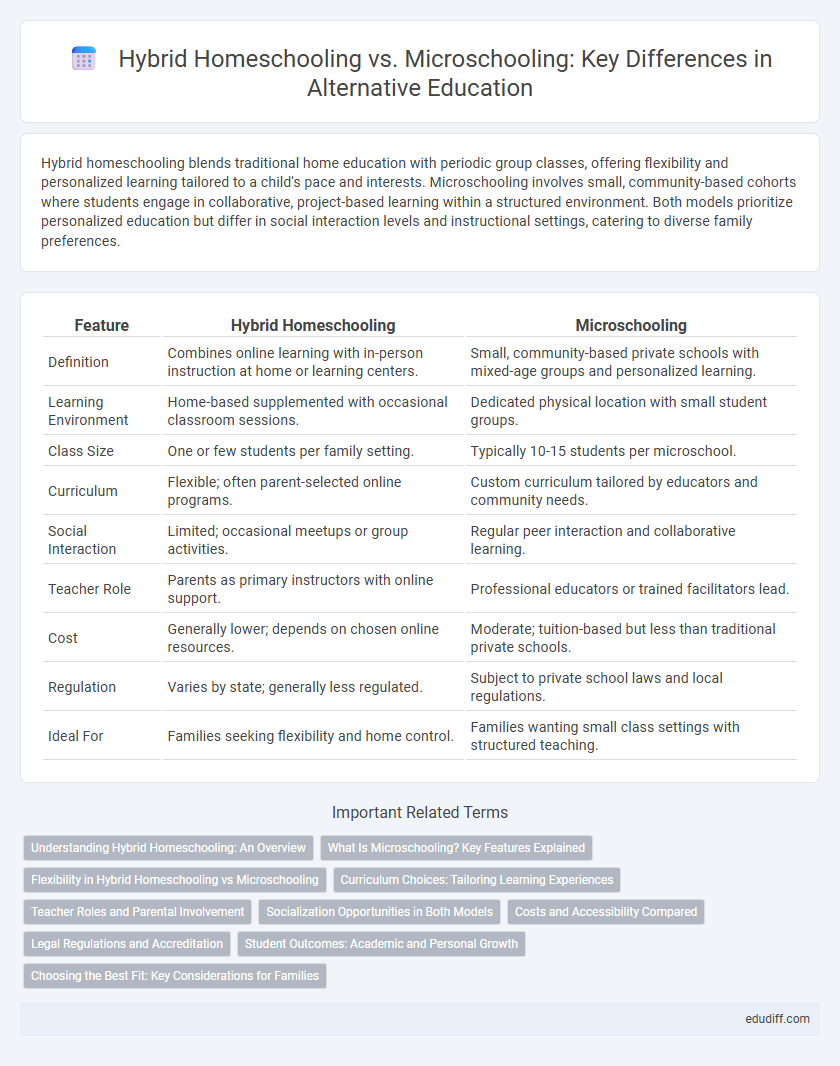Hybrid homeschooling blends traditional home education with periodic group classes, offering flexibility and personalized learning tailored to a child's pace and interests. Microschooling involves small, community-based cohorts where students engage in collaborative, project-based learning within a structured environment. Both models prioritize personalized education but differ in social interaction levels and instructional settings, catering to diverse family preferences.
Table of Comparison
| Feature | Hybrid Homeschooling | Microschooling |
|---|---|---|
| Definition | Combines online learning with in-person instruction at home or learning centers. | Small, community-based private schools with mixed-age groups and personalized learning. |
| Learning Environment | Home-based supplemented with occasional classroom sessions. | Dedicated physical location with small student groups. |
| Class Size | One or few students per family setting. | Typically 10-15 students per microschool. |
| Curriculum | Flexible; often parent-selected online programs. | Custom curriculum tailored by educators and community needs. |
| Social Interaction | Limited; occasional meetups or group activities. | Regular peer interaction and collaborative learning. |
| Teacher Role | Parents as primary instructors with online support. | Professional educators or trained facilitators lead. |
| Cost | Generally lower; depends on chosen online resources. | Moderate; tuition-based but less than traditional private schools. |
| Regulation | Varies by state; generally less regulated. | Subject to private school laws and local regulations. |
| Ideal For | Families seeking flexibility and home control. | Families wanting small class settings with structured teaching. |
Understanding Hybrid Homeschooling: An Overview
Hybrid homeschooling combines traditional homeschooling with part-time enrollment in private or public schools, offering flexible curricula tailored to a child's individual needs. This approach supports personalized learning environments, blending parent-led instruction with professional teaching to enhance socialization and academic progress. Hybrid homeschooling allows families to customize education plans, balancing hands-on learning with structured classroom experiences.
What Is Microschooling? Key Features Explained
Microschooling is a small-scale, community-based educational model that typically serves 5 to 15 students, emphasizing personalized learning and social interaction. Key features include mixed-age classrooms, flexible curriculum tailored to student interests, and a strong focus on collaboration and critical thinking. This approach blends traditional schooling structure with homeschooling flexibility, fostering a supportive environment for individualized academic growth.
Flexibility in Hybrid Homeschooling vs Microschooling
Hybrid homeschooling offers unparalleled flexibility by combining structured online curricula with in-person learning tailored to each student's pace and schedule. Microschooling provides a more consistent, small-group learning environment, which may limit daily scheduling flexibility but fosters collaborative experiences. Families prioritizing highly adaptable educational timetables often find hybrid homeschooling better suits their needs compared to microschool formats.
Curriculum Choices: Tailoring Learning Experiences
Hybrid homeschooling offers a flexible curriculum combining online resources with in-person instruction, allowing families to customize lessons according to their child's pace and interests. Microschooling emphasizes small group settings with personalized curricula often designed collaboratively by educators and parents, fostering deeper engagement and adaptability. Both approaches prioritize tailoring learning experiences but differ in structure, with hybrid homeschooling leaning towards individualized learning and microschooling supporting community-oriented education.
Teacher Roles and Parental Involvement
Hybrid homeschooling features parents actively facilitating learning alongside certified teachers who provide targeted instruction, blending home-based and online education. Microschooling relies on small, in-person teacher-led groups where educators design curriculum and manage daily lessons, reducing direct parental teaching duties. Parental involvement in hybrid homeschooling often centers on coordinating schedules and supporting at-home practice, whereas microschool parents typically assume a supervisory rather than instructional role.
Socialization Opportunities in Both Models
Hybrid homeschooling offers socialization opportunities through scheduled group classes, extracurricular activities, and community events that balance home instruction with peer interaction. Microschooling fosters close-knit social environments by limiting class sizes to small groups, emphasizing collaborative learning and frequent peer engagement. Both models support diverse socialization experiences, with hybrid homeschooling blending structured social settings and microschooling promoting continuous interaction in intimate educational spaces.
Costs and Accessibility Compared
Hybrid homeschooling often requires investment in digital resources and occasional in-person sessions, making costs moderate and flexible, while microschooling typically involves higher fees due to small group instruction and facility use. Accessibility in hybrid homeschooling benefits from online platforms, allowing diverse geographic participation, whereas microschooling's physical presence limits accessibility but fosters stronger community engagement. Budget-conscious families might prefer hybrid options for cost-efficiency and remote learning adaptability, whereas microschooling suits those prioritizing structured environments despite increased expenses.
Legal Regulations and Accreditation
Hybrid homeschooling often operates under state homeschooling laws, requiring parents to comply with specific attendance and reporting guidelines, while microschools typically function as private schools subject to varying accreditation standards and state regulations. Legal regulations for hybrid homeschooling vary widely by state, with some requiring detailed lesson plans and periodic assessments, whereas microschools must often obtain private school accreditation or state approval to ensure educational legitimacy. Accreditation impacts access to funding, credit recognition, and student transfers, making microschools more formally accountable compared to the relatively flexible legal framework governing hybrid homeschooling.
Student Outcomes: Academic and Personal Growth
Hybrid homeschooling combines structured online curriculum with in-person learning, offering personalized academic pacing that enhances student achievement and critical thinking skills. Microschooling fosters small, collaborative environments that boost social interaction, emotional resilience, and adaptive learning through peer engagement. Both models support tailored educational experiences that promote academic excellence alongside personal growth, yet microschooling's community focus often leads to stronger interpersonal development.
Choosing the Best Fit: Key Considerations for Families
Families choosing between hybrid homeschooling and microschooling should evaluate learning style flexibility, social interaction opportunities, and curriculum customization. Hybrid homeschooling offers a blend of traditional and home settings, allowing personalized pacing with occasional group learning, while microschooling provides small, community-based classes promoting peer collaboration. Assessing the child's personality, academic needs, and family scheduling helps determine which alternative education model best supports holistic development.
Hybrid Homeschooling vs Microschooling Infographic

 edudiff.com
edudiff.com